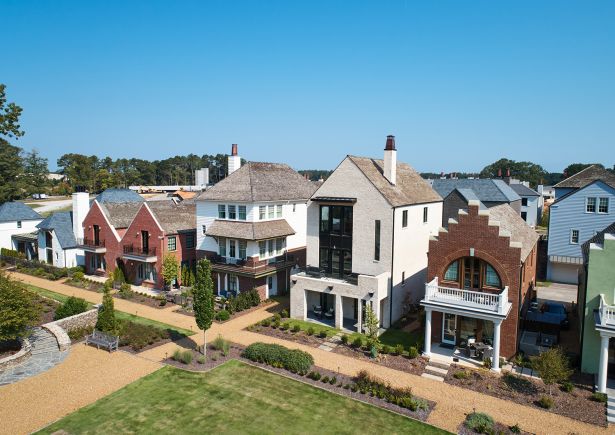This Walkable Georgia Town Uses Geothermal Energy to Power Its Homes
Despite higher upfront costs, using the Earth’s energy to heat and cool homes is catching on
By Anna Staropoli November 1, 2023 11:30 am
reprints
While Trilith Studios in Fayetteville, Ga., paused filming on Marvel’s upcoming “Thunderbolts” and “Blade” productions due to the monthslong writers’ strike, the next-door Town at Trilith didn’t slow down at all.
The Town of Trilith is a master-planned, walkable community anchored by the movie studio lots responsible for a slew of superhero blockbusters — and it has a superpower of its own: Geothermal energy powers the entire community.
The brainchild of billionaire Dan Cathy — the CEO behind Chick-fil-A — Trilith began in 2016. The community takes a globally inspired approach to architecture, where French facades neighbor Nordic-style homes. Home prices range from $500,000 to $4 million, and residents can choose from more than 20 floor plans that run from 500 to 5,000 square feet.
But, while the homes vary widely in design, they share one unifying characteristic: Geothermal is non-negotiable for Trilith’s 750 planned single-family residences.
The community also includes the likes of parks, retailers and, yes, that movie studio, but it’s the single-family homes that specifically trial geothermal innovation.
“We use the Earth to heat and cool our homes,” explained Rob Parker, president of Trilith Development. In simple terms, geothermal communities power their homes using energy from deep underground. The technical explanation is more complex, but geothermal is essentially a resourceful, renewable form of energy that reduces emissions, as well as long-term heating and cooling costs, by use of wells and heat pumps.
Given the scale of its energy commitment, Trilith ranks as one of the largest geothermal communities in the United States. In addition to utilizing the Earth’s energy, the community takes a comprehensive approach to sustainable development. Trilith’s deliberate mixed-use design addresses environmental sustainability from all sides, while simultaneously providing on-site work, leisure and retail opportunities for residents.
Heat rises
Just as geothermal hits at the core of the Earth’s natural resources, it likewise forms the center of Trilith’s heating and cooling strategy.
In April, the United States Department of Energy (DOE) announced a $13 million initiative to help communities across the country design and integrate geothermal technologies. Specifically, the DOE pinpointed 11 geothermal projects nationally that range from urban to remote.
Over the last five to six years, master-planned geothermal communities in particular have become a trend. Near Austin, Texas, the Whisper Valley community is poised to become the country’s largest geothermal development. It remains a work in progress, but plans call for geothermal energy to power some 7,500 homes. Other similar communities include Georgia’s Serenbe — not far from Trilith — and Louisville, Ky.’s Norton Commons.
Also in Louisville, Louisville Muhammad Ali International Airport (SDF) has undertaken a geothermal energy project to the tune of $21.7 million. When finished, the project will heat and cool the airport’s terminal building with energy from the Earth. Churches, hospitals, schools, municipal buildings, and fire and police stations have likewise ventured into the realm of geothermal.
“It’s not just residential geothermal; it’s geothermal in general that is having a moment,” said Ryan Dougherty, president of the Geothermal Exchange Organization, a trade association for the heat pump industry. “I would argue that there’s more rapid growth currently in the commercial and institutional market than there is in the residential single-family home market.”
In Brooklyn, for example, the multifamily development 1 Java Street is slated to be the largest geothermal residential building in New York state.
A few factors — namely, incentives and policies — may explain the widespread adoption of geothermal energy. Specifically, the Biden administration’s Inflation Reduction Act contains incentives for geothermal technology, both on the residential and commercial side, said Dougherty. Emissions limits and climate policy are also driving adoption, particularly in cities like New York that have stringent emissions reduction targets.
Geothermal is likewise geographically versatile. It can be done across all 50 states, so long as you understand your building characteristics and design accordingly.
“You just need to ensure you have enough pipe in the ground, enough connectivity to the Earth, that you can pull the heat that you need out in the winter and put it back in in the summer, because that’s all you’re doing,” said Dougherty. “You’re harvesting and then rejecting thermal energy.”
Here’s the drill
Geothermal isn’t limited to any one type of development, but Trilith focuses on homes, even though it’s a mixed-used community. For the town’s residents, geothermal is not optional, said Parker, as the community requires implementation of the energy source across single-family dwellings, whether a Georgian-inspired townhouse or one of those Nordic residences.
Trilith’s blanket approach to geothermal is driven by a combination of environmental, financial and lifestyle benefits.
On the environmental side, the impact is tangible. According to the DOE’s Geothermal Technologies Office, geothermal is a source of clean energy — meaning, it produces one-sixth of the carbon dioxide of a natural gas power plant. It’s likewise a stable resource; geothermal power plants can operate at any time and in any climate.
“Geothermal heating and cooling systems are the most efficient HVAC technology in existence,” said Dougherty. “They are so efficient because they use the constant temperature of the Earth as a heat source and a heat sink. They use a very small amount of electricity to essentially derive an equivalent four, five, six times that amount in equivalent thermal energy.”
As for the financial benefits, savings occur predominantly over the long term, as the process conserves between 40 to 70 percent of heating energy and therefore reduces utility bills. The upfront costs, however, are more significant. “There’s a little additional cost — about 25 [to] 30 percent more — for your actual system that you buy,” said Parker.
Such upfront costs are related to the skilled technical labor required to install the geothermal systems. Trilith drills wells that, in Georgia, can go straight down to a maximum of 600 feet, said Parker. “You go down 200 feet for every ton of air conditioning,” he added. “So, depending on the size of the home, most homes will use two to three tons of air conditioning.” This means you can dig either two wells or one very deep well.
However, investing in durable infrastructure will lead to long-term efficiencies and savings. “It’s really important to remember that once you put those pipes in the ground, they are essentially there forever,” said Dougherty. “They will be there longer than the home will be there.”
Since residents may balk at the preliminary costs of geothermal energy, Trilith offers two options for how to utilize it. They can either buy a geothermal well or can pay a monthly geothermal access fee, in which Trilith builds the well and residents pay month by month. “Even with paying your geothermal access fee, you’re still saving so much on your heat in the air that it’s a no-brainer decision for everybody,” said Parker.
Geothermal energy also limits noise and creates a more peaceful living environment. There are no noisy outdoor power units, Parker said, so neighborhoods remain quiet.
With geothermal energy underlying its homes, Trilith incorporates additional sustainability measures that consider both EarthCraft and LEED requirements, among other standards, said Parker. During the building stage, Trilith has focused on constructing residences with smaller footprints, thereby using fewer materials and shrinking the amount of space that must be cooled or heated.
From there, Trilith also aims to use building materials that better seal the envelope that separates the indoors from the outdoors. The community likewise embraces smart home technology as well as solar energy. Parker said the combination has the potential to create net-zero houses, or even houses that add energy back into the grid.
Union forever
Trilith’s variety of architectural styles serves both the movie industry and its range of residents.
About 1,000 people live in 300 completed homes in Trilith, though the community will likely house between 3,000 and 4,000 residents once it is fully finished. There are also options to lease single-family homes, though Trilith wants owners to account for 80 percent of residents. In the multifamily sector, 263 of Trilith’s apartments are occupied, with 337 more under development.

The town’s first 400 homes are European in style, though Parker plans for an international approach. “What’s really fun is that we’re now getting ready to jump across our central park that cuts the town in half from a residential standpoint,” said Parker. Next, Trilith will draw inspiration from Asian and Egyptian architectural styles, among others.
The wide architectural sampling allows for easy filming. Homes can serve as makeshift movie sets, which also has a sustainability benefit: Industry personnel can use on-site resources as a back lot rather than burning fuel to travel.
Of course, not everyone at Trilith is in the movie industry, although the community has been quieter since the writers’ strike, said Parker. “What it has proven is that the town will sustain itself even without the industry across the street,” he said. “Although, we refer to that as our beachfront — if seaside has the ocean, we’ve got the studio.”
Subtle, unifying features bring the town together despite the range in home designs, said Parker. For example, similar chimney tops or design themes help transition architectural styles “without making it feel like you’re at Epcot Center and you’re walking from Sweden to Switzerland,” said Parker. “We didn’t want it to be like that. It needed to be authentic because this is where people live.”
Not everyone feels at home at Trilith, though. In 2022, five current and former Black residents sued Trilith for racial discrimination, alleging that repeated racist behavior went unaddressed by the developer. Trilith filed a defense in April, and the lawsuit was in the discovery stage as of October.
Given both the residential and commercial uses of Trilith, the community has been able to decentralize cars, both through the design of homes and the town’s structure. Garages across most of Trilith’s homes are not frontal features, said Parker. Rather, just two out of 300 garages face the street, and that’s only because such a configuration was necessary for getting garages on those two lots.
Everything is within roughly a 10-minute walk, and many residents tend to work at home, at Trilith’s coworking space or at the movie studio, said Parker. The community also includes restaurants, shops, a fitness and wellness center, and a K-12 school.
“There’s a lot of people who don’t get in their car more than once a week or twice a week to go somewhere because they’re living right here,” Parker said.
For comparison, Americans take an average of 1.1 billion trips per day or about four trips per person, according to the Bureau of Transportation Statistics. The sources of these trips vary, but may include travel to the gym, work, the grocery store, school and so forth. However, “in a new urbanist walkable community, that drops down to about seven a week,” said Parker.
Granted, not everything at Trilith is on-site, said Parker. The hospital, for example, is a half-mile away, and the town lacks a grocery store (though it has a small market). There will be times when people drive out for their needs, said Parker, pointing to the community’s proximity to both Atlanta and the Hartsfield-Jackson Atlanta International Airport.
Ultimately, however, the walkability of Trilith promotes both health and wellness, as well as eco-consciousness, extending Trilith’s environmental endeavors. Geothermal is a trend that’s only going to accelerate, said Dougherty.
“I think that there’s going to be a period in the not-too-distant future where people — the majority of Americans — are saying to themselves: ‘Can you believe that we used to pump an explosive, deadly substance into our home to heat it and to heat our water with?’ ” said Dougherty. “Because there’s a safer, healthier, better way, and that is heat pumps.”


